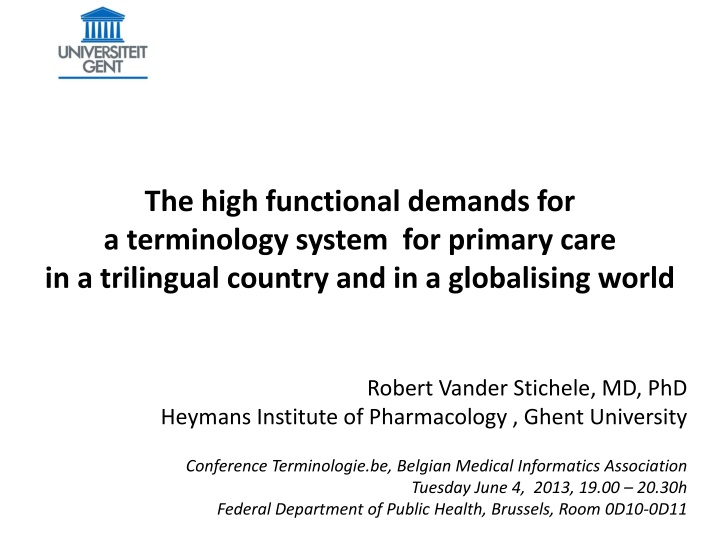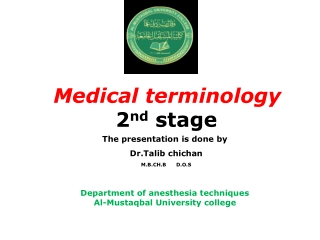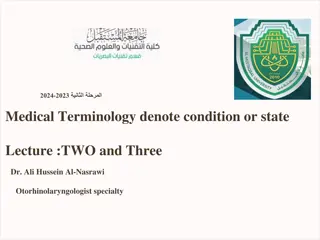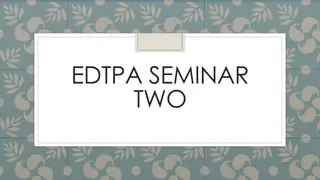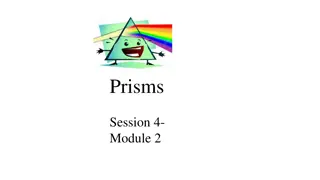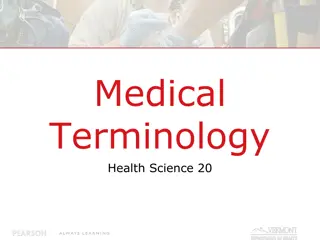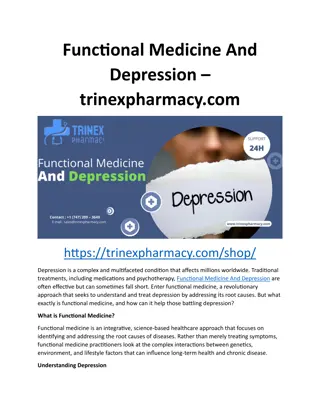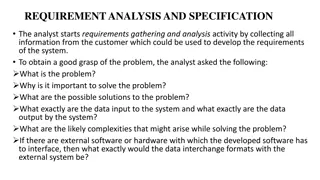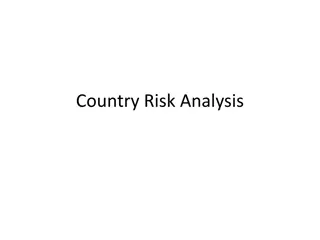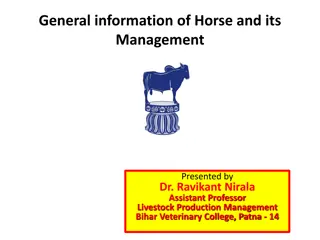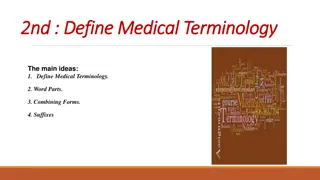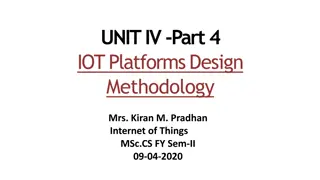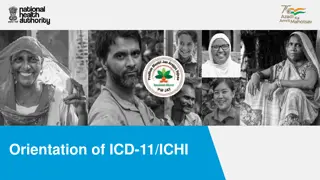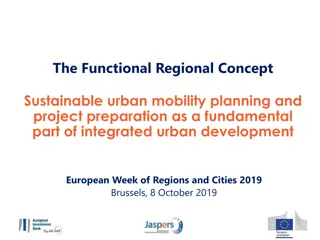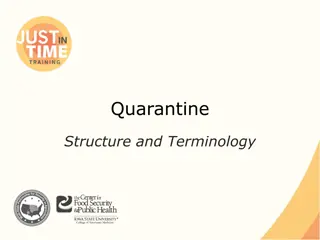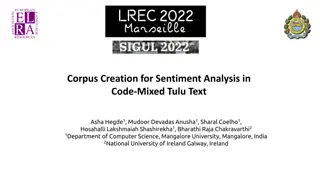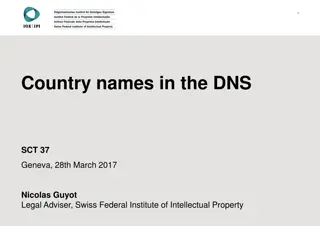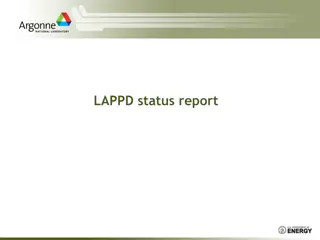Functional Demands for Terminology System in Trilingual Country
This paper discusses the high functional demands for a terminology system in primary care within a trilingual country and a globalized world. Presented by Robert Vander Stichele, MD, PhD, from the Heymans Institute of Pharmacology at Ghent University during a conference on terminologie.
Uploaded on Feb 19, 2025 | 1 Views
Download Presentation

Please find below an Image/Link to download the presentation.
The content on the website is provided AS IS for your information and personal use only. It may not be sold, licensed, or shared on other websites without obtaining consent from the author.If you encounter any issues during the download, it is possible that the publisher has removed the file from their server.
You are allowed to download the files provided on this website for personal or commercial use, subject to the condition that they are used lawfully. All files are the property of their respective owners.
The content on the website is provided AS IS for your information and personal use only. It may not be sold, licensed, or shared on other websites without obtaining consent from the author.
E N D
Presentation Transcript
The high functional demands for a terminology system for primary care in a trilingual country and in a globalising world Robert Vander Stichele, MD, PhD Heymans Institute of Pharmacology , Ghent University Conference Terminologie.be, Belgian Medical Informatics Association Tuesday June 4, 2013, 19.00 20.30h Federal Department of Public Health, Brussels, Room 0D10-0D11
Conflict of interest statement The author - is a general practitioner and a clinical pharmacologist at Ghent University - was a member of the Belgian Working Group on Terminology SEMINOP (2010 2011) - is a member of the research consortium MERITERM (UGENT, CETIC, FBK), keeper of intellectual property rights on terminology, under Common Creative Licence With special thanks to Meriterm members : Joseph Roumier, Elena Cardillo, Marc Jamoulle
OVERVIEW What is a terminology system ? What are the functional demands for an interface terminology ? How far are we and are we on the right track ? How are we going to test this ? Perspective of Primary Health Care Professionals
Terminology system Terminological resources With a structure With a content With functionalities Terminologicalapplications To produce the resources To maintain the resources To use be able to use the resources in practical programs Terminology server To provide access to resources and applications for practical programs Terminology Center To keep resources, applications, and server up-to-date and operational To follow up on governance instructions
Public health GOVERNANCE e-Health Terminology Center Academic expertise Server Business users End-users
What are the functional demands for an interface terminologie ?
Demands for terminology resources in Primary Care Geared to 3 basic functionalities High quality medical registration of daily practice activities Intermittent summaries in a SUMEHR Permanent Episode-ori nted registration Multidisciplinairy registration of care targets Retrieval of bibliographic or EBM information and decision Support Continuous Quality Assurance and epidemiological research => imperative use of GP classifications (ICP and ICD) Suitable for communication with other health care providers In primary care In secundary and tertiary care (30 specialist disciplines) Suitable for communication with patients Suitable for semantic interoperability (language, info systems)
Definition of Semantic Interoperability is the ability to automatically interpret the information exchanged meaningfully and accurately in order to produce useful results as defined by the end users of both systems.
Semantische interoperabiliteit Is a quest to bridge between the wealth and versatility of human language, on the one hand, and the rigidity and precision of registration and classification systems, on the other hand In diferrent languages, in different contexts GP in Primary Care / Health Care / Patient Physician Communication
Language Machine language Word Concept Sense 1 Preferred term Synonym Sense 2 Synonym Synonym
Language Machine language String Match Word Concept Sense 1 Preferred term Synonym Sense 2 Synonym Synonym
Language Machine language Semantic Match Word Concept Sense 1 Preferred term Synonym Sense 2 Synonym Synonym
Recommendation 1 of the SEMINOP Report Our terminological resources within an interface terminology should respect the specific international standards for language resources and for machine language resources. For language : The ISO-standard LMF (Lexical Markup Framework) For machine language : The ISO-standard TMF (Terminological Markup Framework)
Recommendation 2 of the SEMINOP Report Build pragmatic hybrid terminological resources Interface terminology Nomen- clatures Core Set of 15.000 concepts Natural Language Processing resources End-user Terminology Reference Terminology Classifications ISO-LMF ISO- TMF Unilingual Multilingual Thesauri
Further recommendations in the SEMINOP Report Limit in a pragmatic way the number of concepts (to approx; 15.000) and invest in postcoordination Do not limit yourself to SNOMED alone, but also link to other relevant international classifications Assure continuity with past registration by maintaining the existing terminology for primary care (3BT), with legacy conversion Make sure that your information format in the terminological resources allows applications for semantic web (RDF) Use the linguistic expertise present in academic departments for translation technology, computer linguistics and medical informatics. Pay attention to the language of the pati nt (lay language)
How far are we and are we on the right track ?
Governance beslissingen No plenum meetings of SEMINOP since 2 years Round Table ICT in Health : Working group Terminology Ambiguous outcomes (3 contradictory texts) No sign of starting a supervising working group Builiding of a terminological resource (in excel) according to an explicit methodology, with terms from different Belgian sources (VUB, 2BT, RIZIV nomenclagure, ICD translations) around diagnoses and procedures, with linking to SNOMED (already running up to 30.000 terms for diagnoses). A national licence for snomed was subscriberd (a political decision between regional / federal government / Public Health / RIZIV) No public tender for a Terminology Center or Terminology Server
Follow up on SEMINOP Recommendations No use of terminological ISO-standards No use of semantic web technology No contacts with academic centers with linguistic expertice No budget for maintenance of 3BT No budget for attendance of international meetings of primary care classification committees No budget for legacy conversion of registrations in 3BT / ICD No budget for experiments with alternative approach Uncontrolled growth of the number of terms (words) to be managed Only attention to SNOMED Hospitalo-centristic approach, little attention to classifications in primary care No projects to handle lay language and communicataion with patients
Use cases 1. How does the general practitioner evaluates the value of the automatically exported SUMERH from the EMD of a specific patient ? If the quality is not good, is it because registration activity was not good, or is the underlying terminology system to blame ? (see the little encouraging results of the REGM-I project) 2. How user-friendly and accurate is the terminological support evaluated by the general practitioner, when he/she manually corrects the automatacally exported SUMERH to a document that he/she is ready to sign and put on the eHealth platform ? 3. How easy is it to update the SUMERH to new events registered in the journal notes or coming from a discharge letter of a recent hospitalisation ? 4. Does the patient understand the SUMEHR or its lqy lqnguqge version ? 5. Does a French speaking physician from Brussels or Wallonia understands the SUMEHR ? Does an American physician working with openEHR en HL7 understand the SUMEHR ?
Methods for testing Process evaluation How much time was needed ? How much effort was needed ? Where did it went wrong ? Outcome evaluatie How much misundertanding ? How much painfull and dangereous misunderstanding ? Satisfaction of the sender of the reciever
Which methodological approach in testing will save us from this results ? The new cloths of the emperor Hans Christian Andersen, 1837. The emperor is wearing cloths, made by clever tailors, who say that only intelligent people are able to see them.
Conclusion Everybody agrees that it is urgent that something happens. If a sense of urgency brings us to choose one and only solution, then we have a problem : If you only have a hammer, everything looks like a nail There will be a really big problem if after some time the chosen solution turns out to be not as adequate as thought. The ROADMAP for ICT eHEALTH in Belgium tells us what should be ready in 2014 and in 2015. But are the conditions for success present and do we give sufficient attention to alternative, more long-term approaches.
EPILOGUE SAMOURAI RULE 176 SAMOURAI RULE 176
EPILOGUE SAMOURAI RULE 176 SAMOURAI RULE 176 Matters of great importance must be taken lightly
EPILOGUE SAMOURAI RULE 176 SAMOURAI RULE 176 Matters of great importance must be taken lightly SAMOURAI RULE 177 SAMOURAI RULE 177
EPILOGUE SAMOURAI RULE 176 SAMOURAI RULE 176 Matters of great importance must be taken lightly SAMOURAI RULE 177 SAMOURAI RULE 177 Matters of small importance must be taken seriously
